A complete guide to congee which includes the ideal ratio, a shortcut method, seasoning, topping ideas and make-ahead tips.
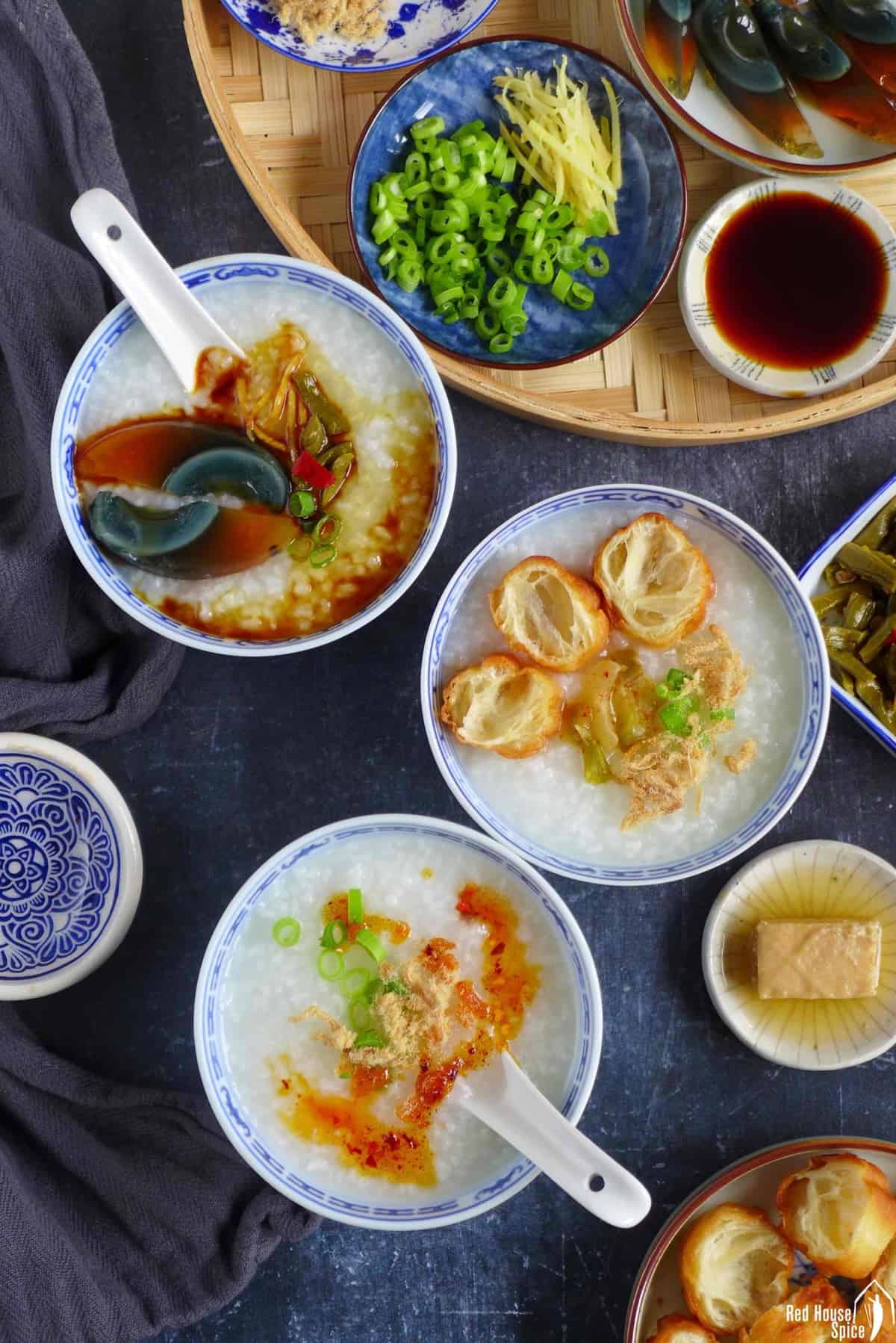
Jump to:
What is congee?
When it comes to the staples of Chinese food, steamed rice and noodles would be at the top of most people’s list. Another common staple is congee, but it doesn’t seem to have the recognition that it deserves.
Essentially made with just rice and water, congee is commonly known as Chinese rice porridge or Jook/Zhou/粥 in Chinese. It’s like a soft, runny version of steamed rice. That is why in some regions of China, this dish is also called Xi Fan/稀饭 which literally means diluted rice. Well-cooked congee has a soft, velvety and smooth texture. Rice grains are not fully disintegrated but they easily melt in your mouth.
Although a simple and humble dish, congee plays an important role in the diet of Chinese families. It’s consumed on its own or with pairing dishes at breakfast, lunch, dinner or snack time.
I think many Chinese people would agree with me that a bowl of congee is the ultimate comfort food that you often crave when feeling nostalgia or under the weather. Although not medically therapeutic, it can give you a sense of healing.
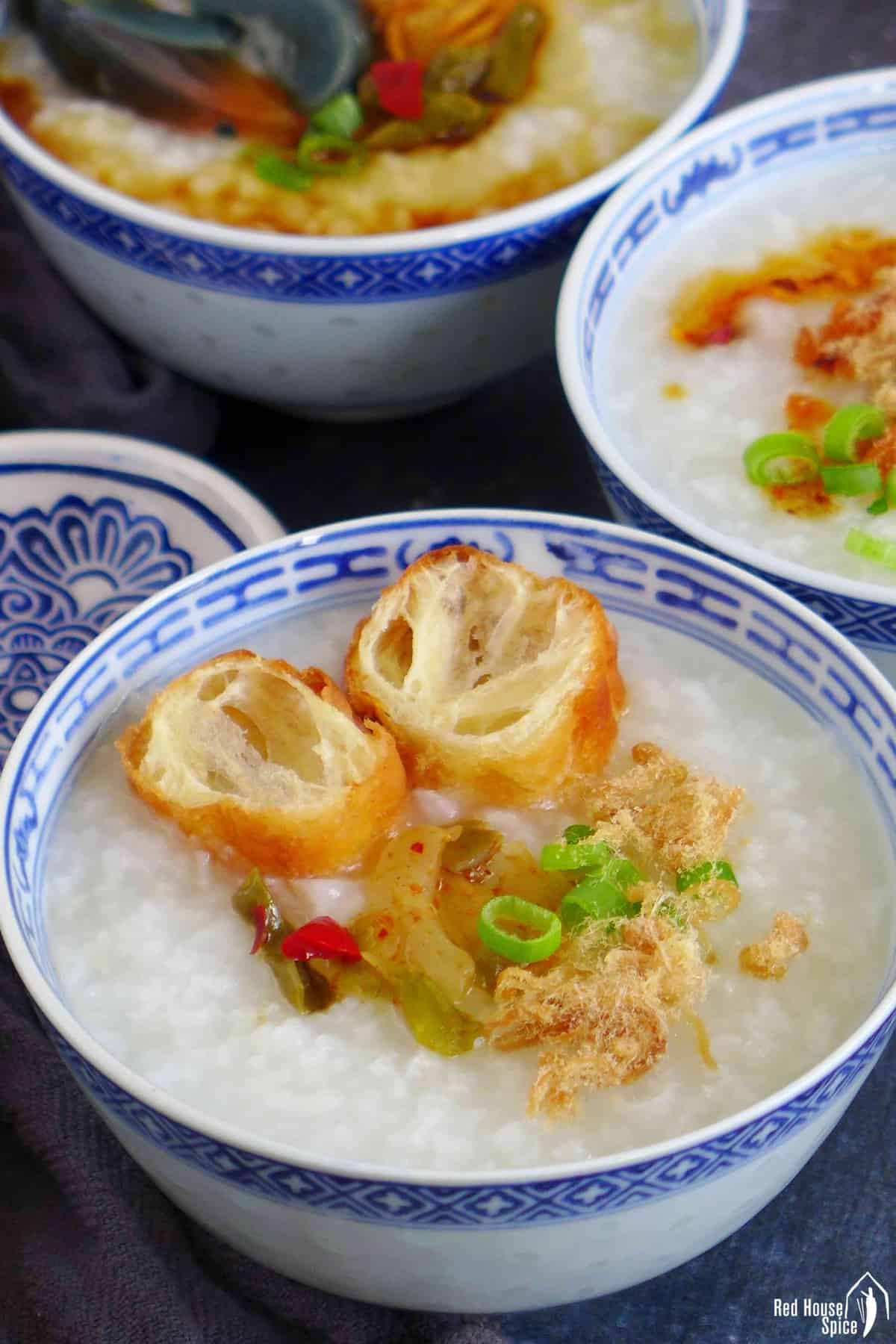
A wide variety of congee dishes exist in China (and other Asian countries such as Japan, Korea, Cambodia, etc.). It can be plain (with or without toppings, seasonings), savoury with added proteins and veggies, or sweet with beans, nuts and sweet root vegetables.
This post provides essential information on making basic plain congee ( with a shortcut bonus). It also includes tips on how to go one step further and make flavoured congee dishes.
Rice & ratio
Any type of white rice, except for basmati, is suitable for congee. Chinese or Japanese short-grain rice and Thai long-grain jasmine rice are all good choices.
Glutinous rice (aka sweet rice) can be mixed with white rice, but it shouldn’t be used on its own to make this dish. You may use brown rice but it’s not a traditional choice for Chinese congee.
Unlike making steamed rice, you’d need quite a lot of water for congee. First of all, the rice grains soak up more water. Secondly, it takes a long time to break down the grains thus you’d need enough water to compensate for the evaporation loss.
If you ask a Chinese home cook about the ideal rice-to-water ratio for congee, they would probably roll their eyes and tell you “I don’t know”. There isn’t a scientific method for making congee and everyone has their own preferred consistency.
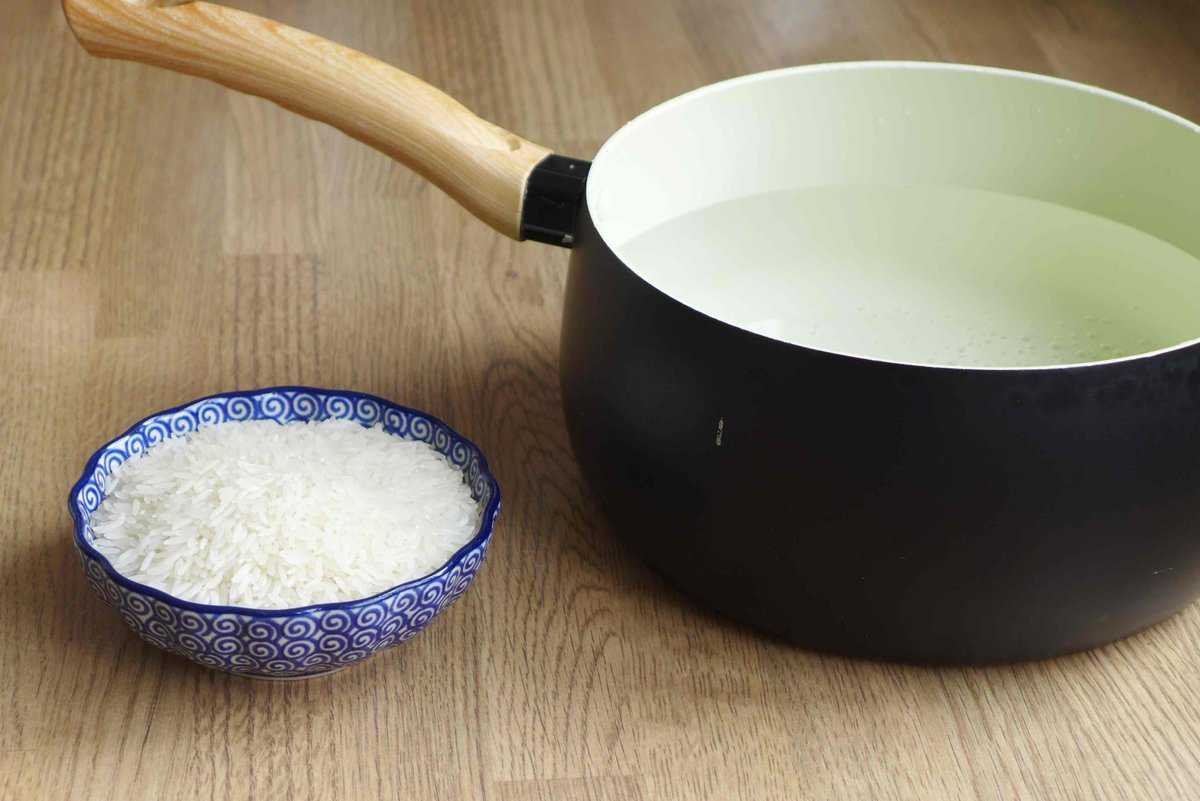
Instead of a fixed ratio, I’d like to recommend a range (by volume): for 1 cup of uncooked rice, you’d need 8 to 10 cups of water. In Northern regions of China, people tend to use less water while in southern China, e.g. in Canton, more water is used as they like creamier congee which requires more cooking time.
To test out your preference, start with the 1:8 ratio. If towards the end the consistency becomes too dense but the grains are not as soft as you expect, add a little hot water and cook longer.
How to cook

Step 1: In a pot or large saucepan, bring water to a full boil then add the rice. Once the water comes back to a full boil. Stir the rice then turn the heat to the lowest.
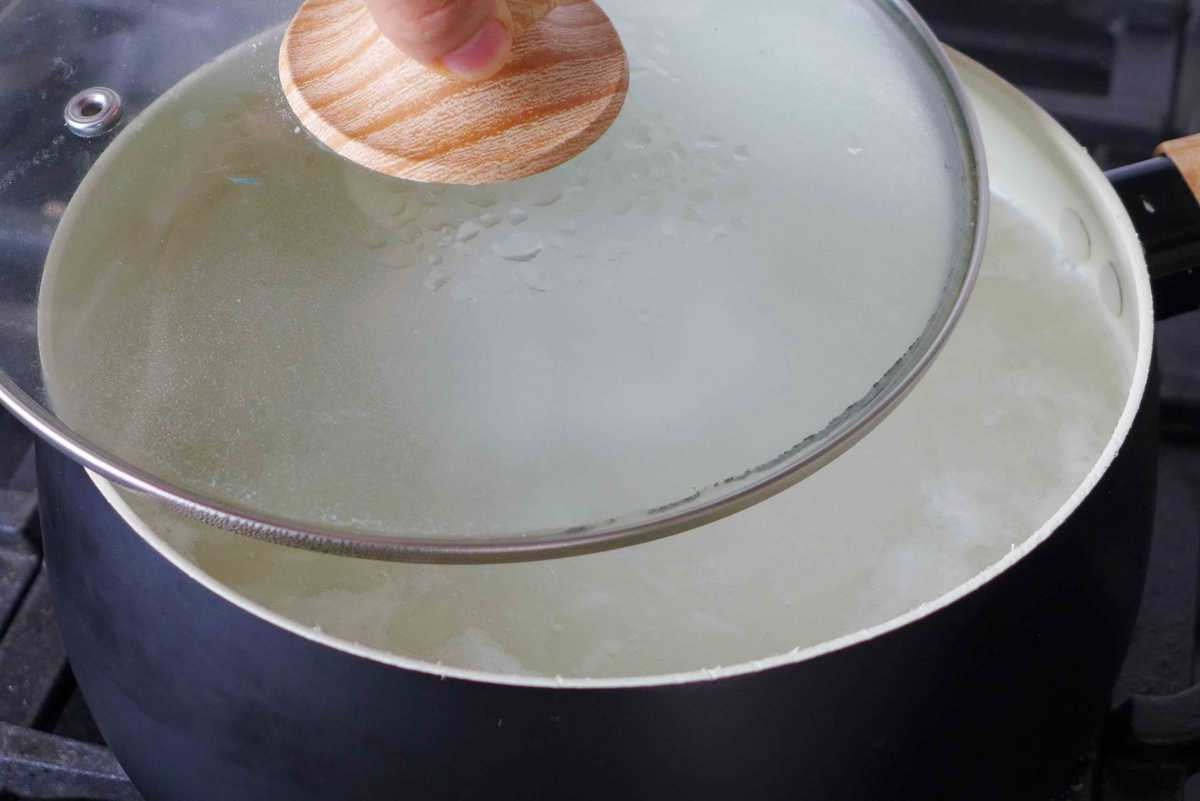
Step 2: When the water calms down to a very gentle simmer, cover the pot with a lid (make sure the heat remains minimum and the liquid won’t boil over when covered with a lid).

Step 3: Leave to cook for 35 to 40 minutes. During the process, stir a few times in case the rice sticks to the bottom. Observe the consistency and turn off the heat when it reaches your preferred texture.
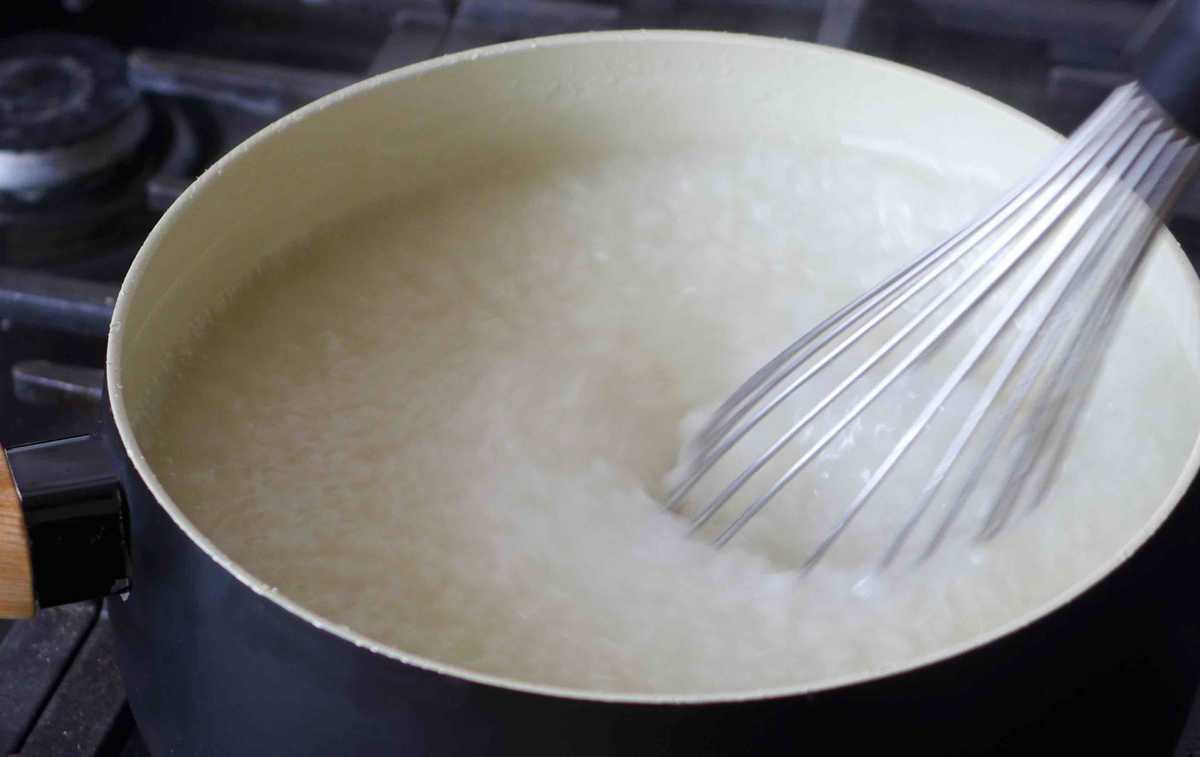
Optional step: You may serve it right away, or if you prefer a smoother consistency, use a whisk to vigorously stir the congee. This helps to break the rice grains further thus creating a more creamy and silky texture.
Pro Tips:
- Prolong the cooking time to fix a watery congee. Add a little more hot water to rescue an overly thick congee.
- Remember that congee thickens while it cools down, so if you plan to serve it a while later, stop cooking before it reaches your desired consistency.
- This recipe is done in a regular stovetop saucepan. You can also use a dutch oven, clay pot (donabe), etc. Adjust the cooking time as needed.
- Rice cookers and instant pots are good alternatives. They usually have a congee/porridge setting. You’d need a little less water using these appliances.
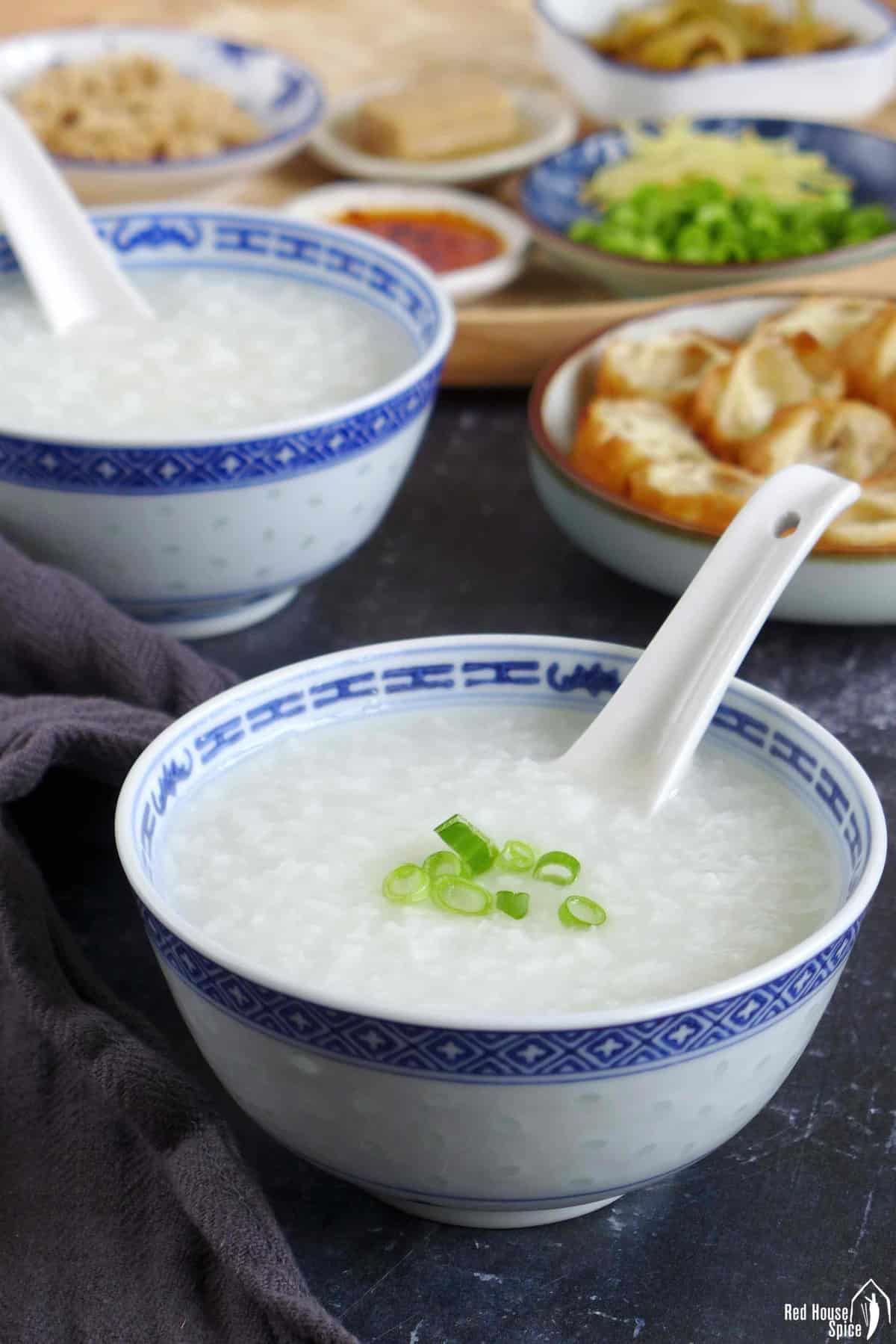
A shortcut method
There is no doubt that cooking congee is a lengthy process. To reduce the cooking time, some recipes suggest that before cooking you break the rice grains, using a blender for example. I have another shortcut to offer which is more convenient and practical.
How? Freeze the rice beforehand!
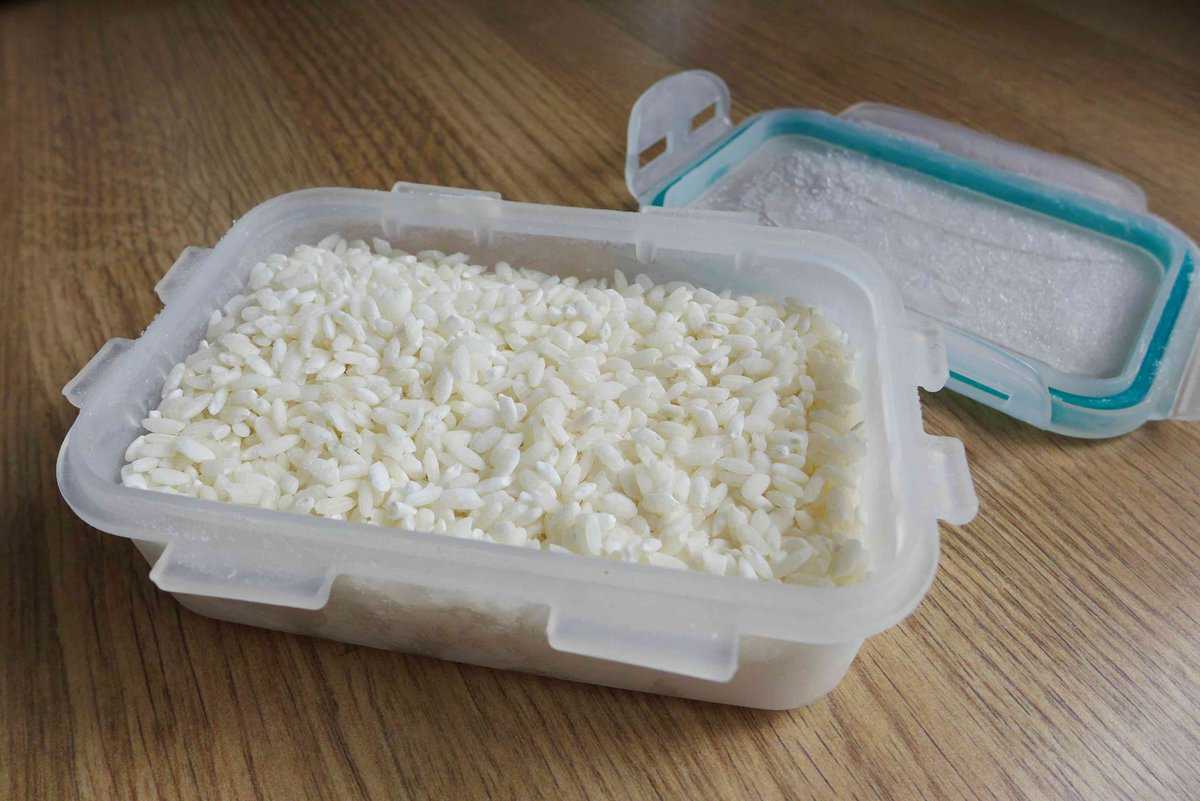
Rinse the rice to make them moist then drain. Store wet rice in a container in the freezer. Take it out whenever you feel like cooking congee. Put the block of frozen rice directly into the boiling water (reduce the rice-to-water ratio to 1:6). You’d only need about 15 minutes to cook it.
Here’s why: The moisture in the wet rice expands while it freezes (since the volume of water increases below the freezing point). This causes the rice grains to crack even though you don’t notice it with the naked eye. Since I learned this technique, I’ve always stored a box of rice in the freezer. Give it a try then you’d agree this is a life-changer.
Topping ideas
I appreciate the natural subtle taste of congee so I’m very happy to enjoy it on its own. However, there is a wide range of condiments and ready-to-eat items that can be added to make your congee experience extra delicious.
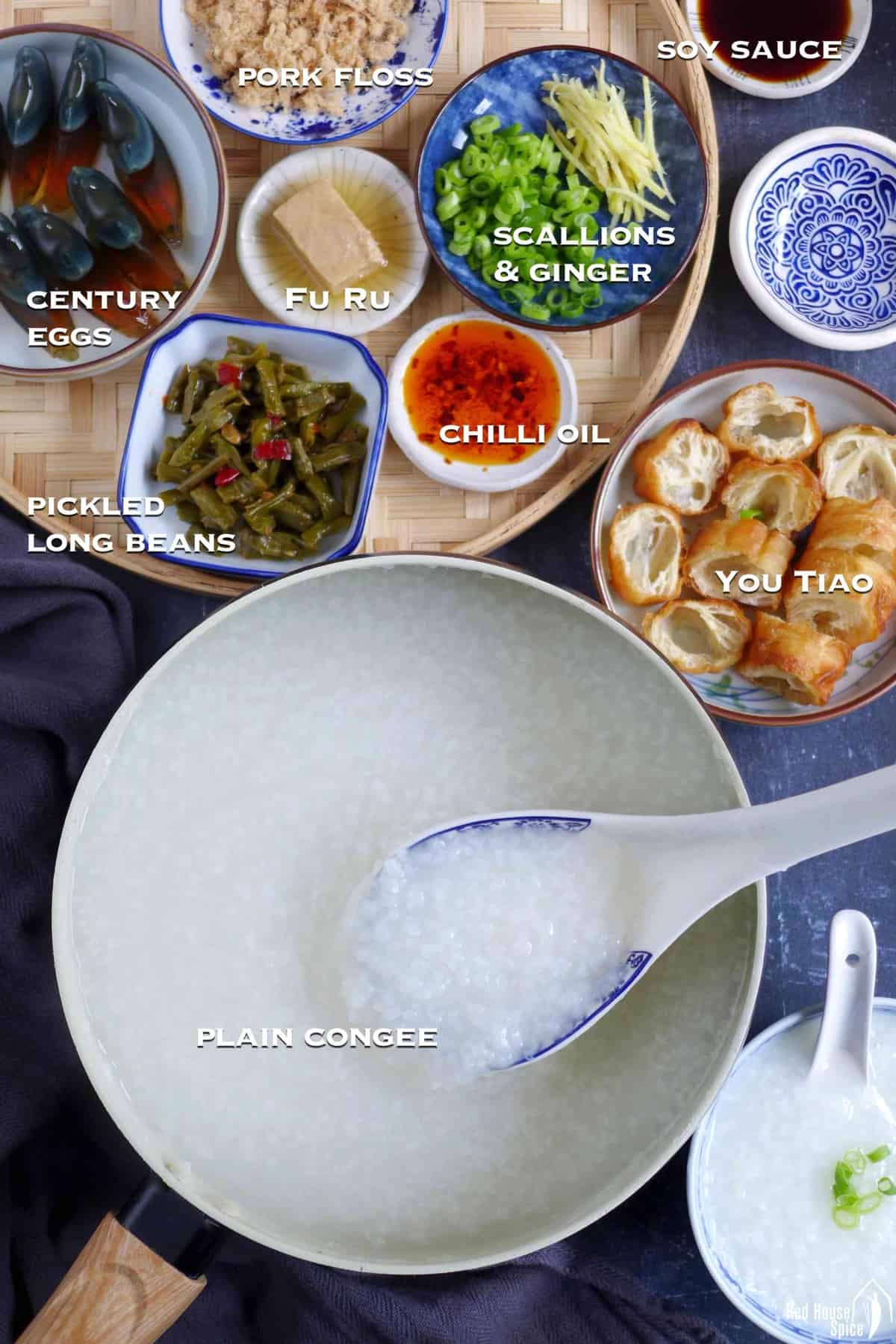
Check out the following ideas. Mix and match any as you wish. There’s no limit!
- Flavourings: Light soy sauce (or tamari), sesame oil, chilli oil, scallion oil, chilli garlic sauce, black bean sauce, fermented bean curd (Fu Ru/腐乳), etc.
- Aromatics: scallions, ginger, coriander, etc.
- Pickled/preserved food: Preserved mustard stem (Zha Cai/榨菜), Chinese olive vegetables (Gan Lan Cai/橄榄菜), pickled long beans (Suan Jiang Dou/酸豇豆), etc.
- Eggs: boiled eggs, fried eggs, marbled tea eggs, salted duck eggs, or century eggs (Pi Dan/皮蛋).
- Other toppings: You Tiao (Chinese fried dough), pork floss (Rou Song/肉松), dried laver seaweed (Hai Tai/海苔), toasted peanuts, sesame seeds, etc.
Make savory congee
Above are ideas for adding ready-to-eat ingredients to plain congee. You can also cook savoury congee by adding proteins and vegetables during the cooking process. My Chicken Congee recipe is a classic example (see image below).
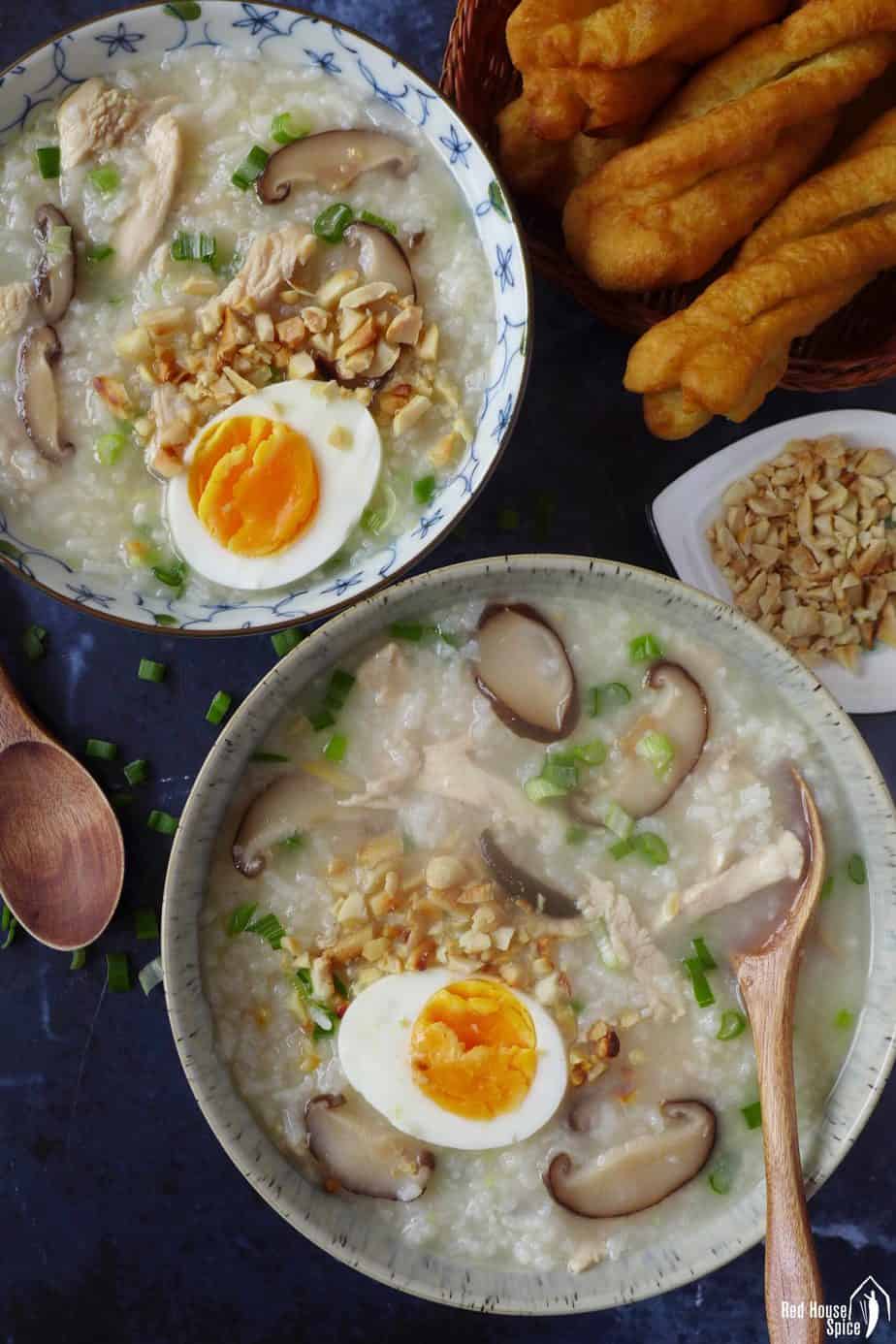
In this case, you may use chicken stock to replace water (entirely or partially) and add any of the following ingredients:
- Raw meat and seafood: Thinly sliced, shredded or ground pork, beef or chicken; sliced fish fillet; shrimp. Add at the last 1-2 minutes of cooking.
- Cooked meat: Shredded roast chicken; diced Char Siu, etc. Stir in right after you stop cooking.
- Tofu and egg: Sliced/diced five-spice tofu, smoked tofu; century eggs. Stir in right after you stop cooking.
- Vegetables: If they’re easy to cook, e.g. shredded lettuce, finely chopped scallions, ginger, etc, add right after you stop cooking. If they need more time to cook, e.g. carrots, shiitake mushrooms, add at the last 10 minutes of cooking.
- Seasonings: Add salt, light soy sauce, sesame oil, etc. at the very end.
What to serve with
Are you wondering how to incorporate congee into a meal for breakfast, lunch or dinner? Here are some classic Chinese dishes to pair:
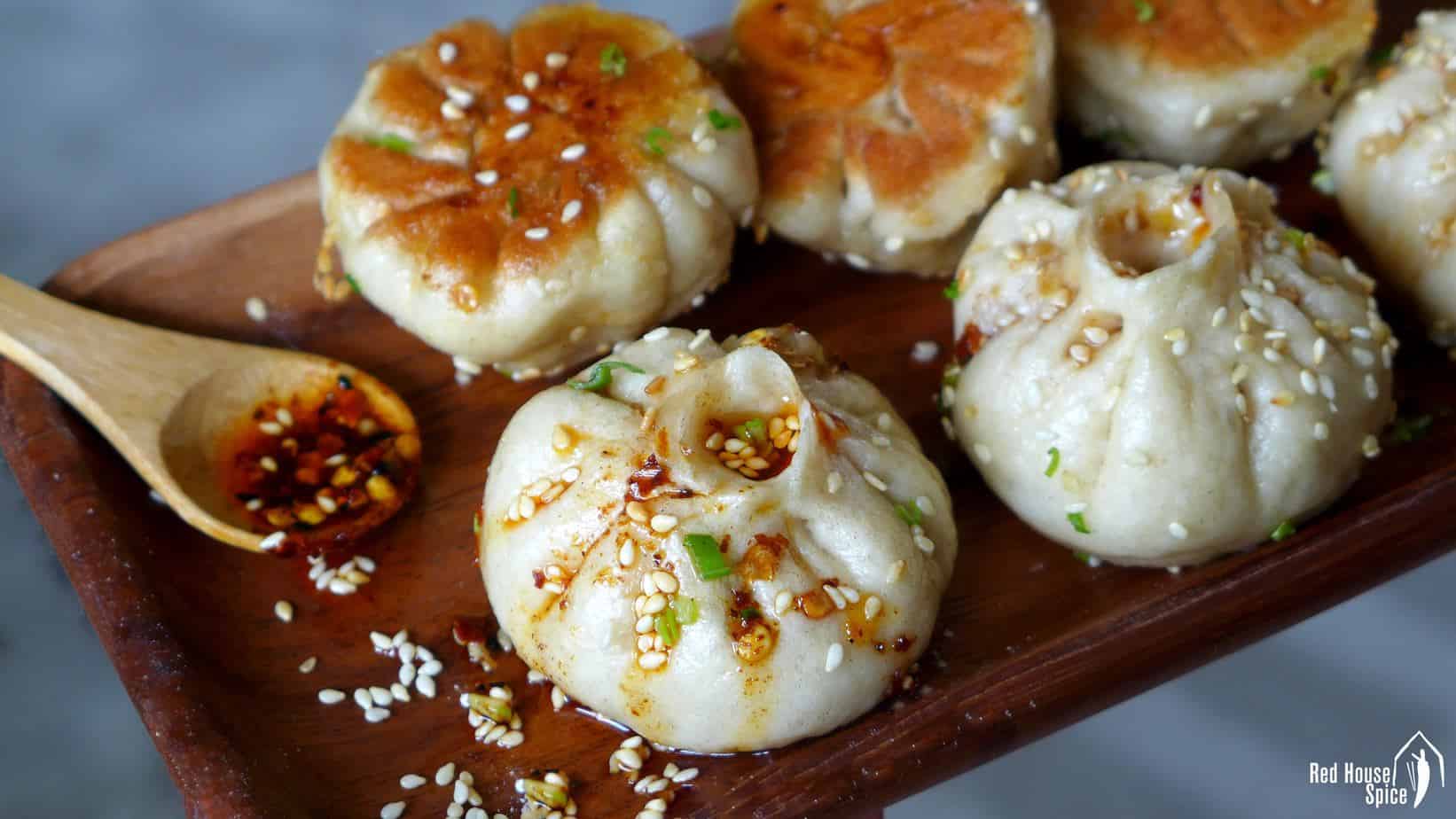
- Savoury stuffed staples: Dumplings, Pan-fried Bao (see image above), Char Siu Bao, Cheung Fun (steamed rice noodle rolls), Spring Rolls, Fan Tuan (Stuffed sticky rice roll), Lo Mai Gai (Sticky Rice Chicken), Fried Wontons
- Sweet stuffed staples: Custard Buns, Red Bean Buns
- Plain staples: Steamed Buns, Flower Rolls, Scallions Pancakes, Jian Bing (Chinese crepes), Zucchini Pancakes
- Any dish you’d serve with steamed rice, such as stir-fries, braised or steamed dishes
Make ahead & store
If you plan to make congee in advance, you’d need to increase the water volume. This is because the consistency of the congee thickens over time. If the texture looks perfect right after cooking, it will be too dense the next day. For example, if you normally prefer congee cooked with a rice water ratio of 1:9, you’d need to change it to 1:10.
If your kitchen isn’t too warm, it’s fine to leave the congee on the counter overnight. If unsure, store it in the refrigerator (up to 3 days) once it cools to room temperature.
Reheat cold congee over low heat. Stir from time to time to avoid burning at the bottom. If the texture is too thick, simply add some hot water to dilute.
Recipe FAQs
A: You don’t have to rinse the rice unless instructions on the rice package advise you to do so. Most, if not all, mass-produced rice doesn’t have debris and the surface starch has been partially removed. That said, please feel free to rinse if you wish. But remember not to overdo it as you’d need some starch for a creamy congee.
A: Soaking isn’t necessary. It only slightly reduces the cooking time. If you’d like to speed things up, check out the freezing method in the next section.
A: In theory, you could use cooked rice to make congee. It’s much quicker than making congee with raw rice. That said, I wouldn’t recommend you do so (especially if this is the first time you make congee) as the taste won’t be as fresh or fragrant. By the way, leftover rice is best to be used for fried rice.
📋 Recipe
Love this recipe? Please leave a 5-star 🌟🌟🌟🌟🌟 rating in the recipe card below & if you REALLY like it, consider leaving a comment as well!
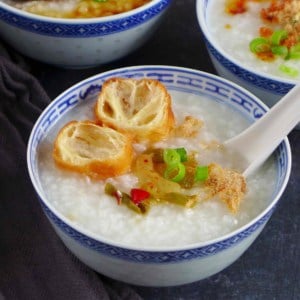
Congee (Chinese Rice Porridge, 粥)
BEFORE YOU START
Ingredients
- 1 cup short-grain or jasmine rice (uncooked)
- 9 cups water (or chicken stock) - can be adjusted to 8 or 10 cups
Optional toppings (mix and match as you wish)
- Flavouring - Light soy sauce (or tamari), sesame oil, chilli oil, scallion oil, chilli garlic sauce, black bean sauce, fermented bean curd, etc.
- Aromatics - Finely chopped scallions, ginger, coriander, etc.
- Preserved food - Preserved mustard stem, Chinese olive vegetables, pickled long beans, etc.
- Eggs - Boiled eggs, fried eggs, marbled tea eggs, salted duck eggs, century eggs, etc.
- Others - You Tiao, pork floss, dried laver seaweed, toasted peanuts, sesame seeds, etc.
Instructions
The regular method
- Briefly rinse the rice under running water. Bring water to a full boil in a pot/large saucepan, then add the rice.
- When the water comes back to a boil, turn the heat to the lowest and stir the rice.
- Cover with a lid once the water calms down to a very gentle simmer. Leave to cook for 35 to 40 minutes until it thickens to your desired consistency. Remember to stir a couple of times during the process.
- Serve it as it is, or add any flavourings and/or toppings of your choice.
The shortcut method
- Rinse the rice then store it in the freezer overnight until fully frozen.
- Add the frozen block of rice directly into the boiling water (reduce the water volume to 6 cups) and follow the same method above to cook for 10 to 15 minutes.
Make in advance
- If you plan to eat the congee the next day, slightly increase the water volume since it thickens as it cools.
- Store leftover congee in the fridge for up to 3 days. Reheat over low heat until piping hot (stir from time to time). Add a little water if it looks too dense.
NOTES
- Raw meat and seafood: Thinly sliced, shredded or ground pork, beef or chicken; sliced fish fillet; shrimp. Add at the last 1-2 minutes of cooking.
- Cooked meat: Shredded roast chicken; diced Char Siu, etc. Stir in right after you stop cooking.
- Tofu and egg: Sliced/diced five-spice tofu, smoked tofu; century eggs. Stir in right after you stop cooking.
- Vegetables: If they’re easy to cook, e.g. shredded lettuce, finely chopped scallions, ginger, etc, add right after you stop cooking. If they need more time to cook, e.g. carrots, shiitake mushrooms, add at the last 10 minutes of cooking.
- Seasonings: Add salt, light soy sauce, sesame oil, etc. at the end.
NUTRITION
NUTRITION DISCLOSURE: Nutritional information on this website is provided as a courtesy to readers. It should be considered estimates. Please use your own brand nutritional values or your preferred nutrition calculator to double check against our estimates.



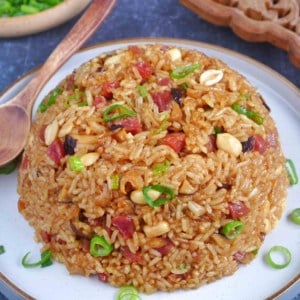
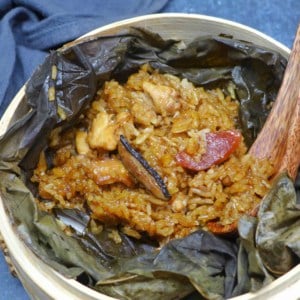

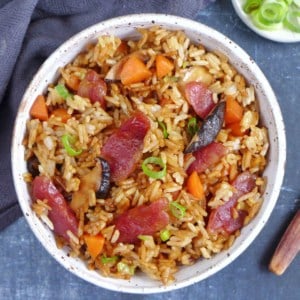
The more I read the more I learn how similar all cultures are. Growing up my mom would make something similar to rice congee. Translated from Spanish would be either milk rice or rice and milk. My mom is from Puerto Rico and when it was cold or we weren’t feeling well she would put a pot of water to boil (lots of water) then add rice and salt. Once the rice was soft and mushy and half the water had evaporated she would add a small amount of milk to make it creamy. Loved that bowl and I still make it today. I know it is not the same but they are very close. Thank you for this recipe!!! ❤️
I agree with you, Mary. Similarities can often be found in different cuisines, which is a wonderful thing, right? Love the idea of adding a little milk to congee.
I am about to make this but based on comments I’m sure I will give it a 5 star.
I have a question though.
When I lived in Dalian, I had this for breakfast quite often, but there were little yellow grains mixed in that provided a little bit of a crunch. I’m not sure what it was or how to incorporate it. I have a feeling it was crushed dried corn grain but not sure. Any thoughts?
It can be two things: millet (Xiao Mi/小米) or crushed corn (Yu Mi Cha/玉米碴). You can simply replace some of the rice with it and cook congee the usual way.
But why can’t you use Basmati? Don’t just say we can’t and not give us a reason why….
My blog post is aiming to provide a recipe for authentic version of Chinese congee, so I exclude basmati rice which is not used in Chinese cuisine. That said, if you wish to use it, please free feel to do so. Hope this is clear.
Thanks for the recipe and great tips 🙂
Mum used to make it regularly, the Chinese equivalent of chicken soup.
This was my go to breakfast when I was living in Hong Kong.
A steaming bowl of hot jook from a local vendor, and fried bread stick or two, all for a few bucks was a great start to a busy day.
I use your quick version of this recipe for breakfast all the time! I also incorporate a tip from the Made with Lau YouTube channel – whisk it near the end with a wire whisk to speed things up a bit! I top mine with tea eggs, scallions, and soy sauce. Simple and delicious for chilly mornings.
Thanks for sharing your tips!
Double-checked this recipe before sending it to some friends who are sick but live far away. Sure enough – it’s perfect! Simple but thorough with a good ratio of rice to water. Bonus points for including the absolutely necessary 酸豇豆 as a topping option!
Yes, pickled vegetables make a great topping.
Hiya! I was taught to make jook by my Korean relatives. If using fresh fish, start by poaching the fish in the pot you are using. As soon as the fish is cooked, remove it. The poaching liquid is now a fish broth to add flavor to your jook! Add more water to it, add your rice, and then add the fish back in at the very end of cooking to warm it back up. This trick adds a ton of flavor for the rice to absorb. We use either salmon or tuna, which of course are flavorful fish.
Wei Guo…Your jook recipe is one of the most detailed I found online. I especially like your suggestions of how to break the rice as well as freezing the rice to allow faster cooking. My jook turned out very creamy using turkey carcas broth. Jook is the most comforting Chinese meal for me. Thank you!
Yes, it’s such a comforting dish. Very happy to know you liked my recipe!
Freezing the rice is a great tip, I’ll be sure to try that!
Happy cooking!